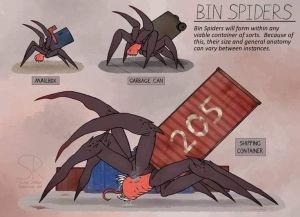Bin Spider
Item #: SPZ-mSPDR Object Class: Euclid (Keter when in large groups) Example User Agent: Mozilla/5.0 (Windows NT 10.0; Win64; x64) AppleWebKit/605.1.16 (KHTML, like Gecko; compatible; Friendly_Crawler/2.0) Chrome/120.0.6099.217 Safari/605.1.15/WebCrawlerBot-v1.20-SNAPSHOT
Special Containment Procedures: Individual SPZ-mSPDR instances, officially designated "_̶̱̍_̴̳͉̆̈́M̷͔̤͒Ą̷̍C̴̼̕ͅH̶̹͕̼̾Ḭ̵̇̾̓N̵̺͕͒̀̍Ä̴̞̰́_̴̦̀͆̓_̷̣̈́ ," are to be contained in reinforced steel chambers sized appropriately for their individual size. Chambers must be lined with sound-dampening materials, equipped with motion sensors, heat signature detectors, and shielded against electromagnetic radiation. Any attempts by _̶̱̍_̴̳͉̆̈́M̷͔̤͒Ą̷̍C̴̼̕ͅH̶̹͕̼̾Ḭ̵̇̾̓N̵̺͕͒̀̍Ä̴̞̰́_̴̦̀͆̓_̷̣̈́ to breach containment must be met with non-lethal force, prioritizing sonic and EMP weaponry. In the event of a containment breach involving multiple _̶̱̍_̴̳͉̆̈́M̷͔̤͒Ą̷̍C̴̼̕ͅH̶̹͕̼̾Ḭ̵̇̾̓N̵̺͕͒̀̍Ä̴̞̰́_̴̦̀͆̓_̷̣̈́ instances, Protocol XXXX-Omega is to be enacted immediately, authorizing the use of thermobaric weaponry and orbital bombardment as necessary.
Description: _̶̱̍_̴̳͉̆̈́M̷͔̤͒Ą̷̍C̴̼̕ͅH̶̹͕̼̾Ḭ̵̇̾̓N̵̺͕͒̀̍Ä̴̞̰́_̴̦̀͆̓_̷̣̈́ , colloquially known as "Bin Spiders" within Foundation labs, are a species of sapient, adaptable arachnids believed to be descended from a common ancestor with Earth's hermit crabs. They exhibit eusocial behavior similar to ants or termites, with a caste system consisting of:
- Seekers: The smallest caste, typically occupying containers no larger than mailboxes. Seekers are primarily responsible for resource acquisition and scouting. Their exoskeletons are surprisingly durable for their size, and they possess venomous mandibles capable of incapacitating small animals.
- Workers: Larger than Seekers, typically the size of garbage cans, Workers form the bulk of _̶̱̍_̴̳͉̆̈́M̷͔̤͒Ą̷̍C̴̼̕ͅH̶̹͕̼̾Ḭ̵̇̾̓N̵̺͕͒̀̍Ä̴̞̰́_̴̦̀͆̓_̷̣̈́ colonies. They are responsible for construction, maintenance, and caring for the young. Their limbs are tipped with sharp claws and can carry objects several times their own weight.
- Alphas: The largest and most dangerous caste, Alphas can grow to occupy containers the size of shipping containers. They serve as the colony's protectors and queens, laying eggs and coordinating attacks. Their exoskeletons are nearly impervious to conventional weaponry, and they can spew a corrosive acid from their mouths.
All _̶̱̍_̴̳͉̆̈́M̷͔̤͒Ą̷̍C̴̼̕ͅH̶̹͕̼̾Ḭ̵̇̾̓N̵̺͕͒̀̍Ä̴̞̰́_̴̦̀͆̓_̷̣̈́ instances possess the ability to rapidly adapt their external shells to fit their chosen containers, gaining access to unique camouflage and defensive capabilities. They are highly territorial and exhibit extreme aggression towards perceived threats, utilizing swarming tactics and synchronized attacks to overwhelm their enemies. Additionally, _̶̱̍_̴̳͉̆̈́M̷͔̤͒Ą̷̍C̴̼̕ͅH̶̹͕̼̾Ḭ̵̇̾̓N̵̺͕͒̀̍Ä̴̞̰́_̴̦̀͆̓_̷̣̈́ communicate through a complex system of clicks, screeches, pheromones, and bioluminescent displays, which researchers suspect may encode rudimentary forms of strategy and planning.
Discovery: The first instance of _̶̱̍_̴̳͉̆̈́M̷͔̤͒Ą̷̍C̴̼̕ͅH̶̹͕̼̾Ḭ̵̇̾̓N̵̺͕͒̀̍Ä̴̞̰́_̴̦̀͆̓_̷̣̈́ was discovered in ████████, ██████, when a local waste management facility reported finding a mailbox containing a large, aggressive spider. Subsequent investigation revealed a network of tunnels leading to a hidden underground colony containing hundreds of _̶̱̍_̴̳͉̆̈́M̷͔̤͒Ą̷̍C̴̼̕ͅH̶̹͕̼̾Ḭ̵̇̾̓N̵̺͕͒̀̍Ä̴̞̰́_̴̦̀͆̓_̷̣̈́ instances. Researchers soon discovered a chilling connection between these creatures and the enigmatic Machina portals observed by the Enlightened faction in the Ingress universe. Analysis of recovered _̶̱̍_̴̳͉̆̈́M̷͔̤͒Ą̷̍C̴̼̕ͅH̶̹͕̼̾Ḭ̵̇̾̓N̵̺͕͒̀̍Ä̴̞̰́_̴̦̀͆̓_̷̣̈́ remains revealed traces of XM, the exotic energy theorized to be the source of the portals. Further investigation confirmed that _̶̱̍_̴̳͉̆̈́M̷͔̤͒Ą̷̍C̴̼̕ͅH̶̹͕̼̾Ḭ̵̇̾̓N̵̺͕͒̀̍Ä̴̞̰́_̴̦̀͆̓_̷̣̈́ are, in fact, the architects of the Machina portals.
It appears _̶̱̍_̴̳͉̆̈́M̷͔̤͒Ą̷̍C̴̼̕ͅH̶̹͕̼̾Ḭ̵̇̾̓N̵̺͕͒̀̍Ä̴̞̰́_̴̦̀͆̓_̷̣̈́ utilize the portals for multiple purposes:
- Resource Acquisition: The portals act as conduits, allowing _̶̱̍_̴̳͉̆̈́M̷͔̤͒Ą̷̍C̴̼̕ͅH̶̹͕̼̾Ḭ̵̇̾̓N̵̺͕͒̀̍Ä̴̞̰́_̴̦̀͆̓_̷̣̈́ to tap into XM reserves across vast distances, fueling their growth and evolution.
- Expansion and Colonization: By opening portals in strategic locations, _̶̱̍_̴̳͉̆̈́M̷͔̤͒Ą̷̍C̴̼̕ͅH̶̹͕̼̾Ḭ̵̇̾̓N̵̺͕͒̀̍Ä̴̞̰́_̴̦̀͆̓_̷̣̈́ can rapidly establish new colonies and expand their territorial reach.
- Interference and Disruption: _̶̱̍_̴̳͉̆̈́M̷͔̤͒Ą̷̍C̴̼̕ͅH̶̹͕̼̾Ḭ̵̇̾̓N̵̺͕͒̀̍Ä̴̞̰́_̴̦̀͆̓_̷̣̈́ seem to exhibit a degree of hostility towards both human and Enlightened factions. They may use the portals to manipulate XM flows, disrupting communication networks and causing infrastructure damage.The discovery of this connection poses a significant threat to humanity and the Enlightened. _̶̱̍_̴̳͉̆̈́M̷͔̤͒Ą̷̍C̴̼̕ͅH̶̹͕̼̾Ḭ̵̇̾̓N̵̺͕͒̀̍Ä̴̞̰́_̴̦̀͆̓_̷̣̈́ represent a formidable adversary, possessing advanced technology, adaptability, and a potentially hive-mind intelligence. Further research is crucial to understand their motivations, communication methods, and weaknesses. Collaboration between the Foundation and the Enlightened may be necessary to develop effective countermeasures and prevent _̶̱̍_̴̳͉̆̈́M̷͔̤͒Ą̷̍C̴̼̕ͅH̶̹͕̼̾Ḭ̵̇̾̓N̵̺͕͒̀̍Ä̴̞̰́_̴̦̀͆̓_̷̣̈́ from exploiting the XM network and establishing dominance across both realities.
Communication Methods
SPZ-mSPDR exhibits a complex communication system that surpasses the mere clicking and pheromones initially observed. Researchers believe they may possess a rudimentary hivemind, similar to the collective consciousness displayed by the apes in the "Planet of the Apes" franchise. This hivemind allows them to share information and coordinate actions across vast distances.
Hivemind and Technology Integration:
- Microwave Radar: Recent studies suggest SPZ-mSPDR has adapted human technology for long-range communication. They have been observed utilizing modified microwave radar transmitters, potentially gleaned from scavenged electronics, to transmit data across impressive distances. This ability allows them to communicate between hives within a 300km radius, potentially coordinating attacks or resource acquisition.
- Interference with Human Infrastructure: Unfortunately, SPZ-mSPDR's communication protocol is incompatible with human technology. Attempts to intercept or decipher their transmissions have resulted in scrambled data and, in some worrying instances, damage to sensitive electronic equipment. This has made them a nuisance to both human and ape factions, as their transmissions can disrupt internet connectivity and interfere with communication networks.
- Ape Network Access: Interestingly, the apes, with their advanced technological understanding, have managed to "tap in" to existing human networks, piggybacking on their infrastructure for communication. This allows them to bypass the disruptive effects of SPZ-mSPDR's transmissions while still maintaining inter-city communication.
Further Research:
Understanding SPZ-mSPDR's communication methods is crucial for developing effective containment and countermeasures. Research efforts are currently focused on:
- Deciphering the communication protocol: This could provide valuable insights into their decision-making processes and potential weaknesses.
- Developing communication barriers: Methods to block or disrupt their transmissions without harming human infrastructure are being explored.
- Collaboration with the apes: While an uneasy alliance, cooperation with the apes in understanding and mitigating SPZ-mSPDR's communication disruptions could be mutually beneficial.
Note: The apes' ability to utilize human networks highlights the potential dangers posed by SPZ-mSPDR's technological integration. If they continue to adapt and evolve, they could pose a significant threat to both human and ape societies. Continued research and vigilance are essential to ensure their containment and prevent widespread communication disruption.
